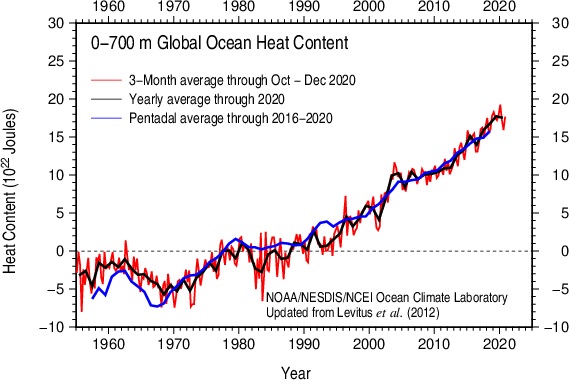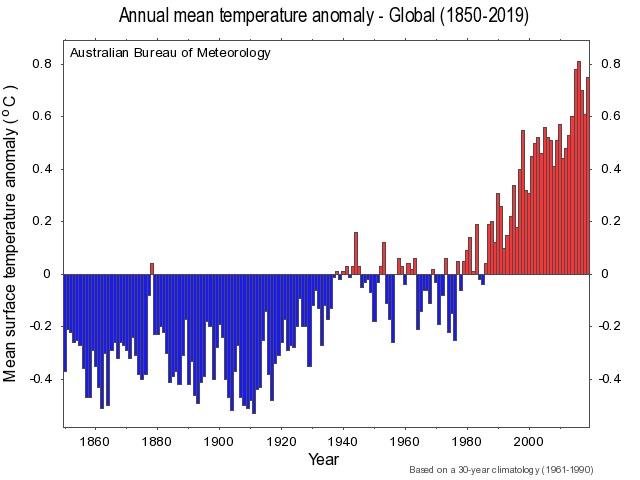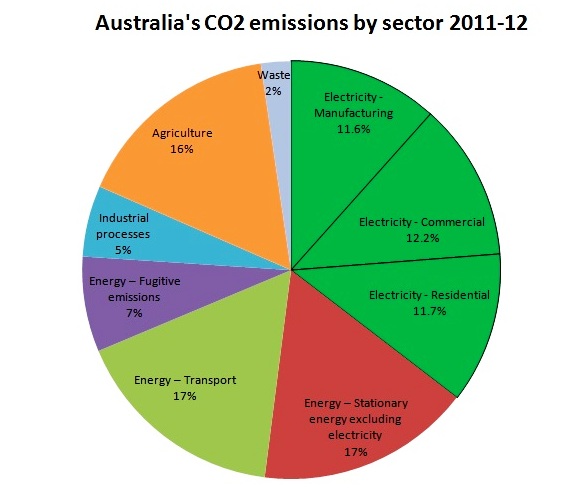
Global Heating
- Manmade greenhouse gas emissions are changing our climate
- Nuclear energy must be Australia’s key energy resource if we are to address the magnitude of our greenhouse gas emissions
- Of necessity we must address system wide emissions and performance
- An outline of the characteristics of carbon abatement
Edition 4, Revised 24/5/2021
Manmade greenhouse gas emissions are changing our climate
Mankind will have to exist in an environment substantially different to that in which he evolved. The implications for all plant and animal species on the planet are profound.
The impact of a minor period since the beginning of the industrial revolution is destined to reshape our destiny for millennia. We have the tools and knowledge to address this threat and the adopting nuclear energy is the most effective measure that our nation can carry out to meet the challenge.
Evidence for manmade climate change and its impacts are very well documented. The following five links provide detailed analysis and discussion:
- NASA’s Climate Change and Global Warming,
- Australia’s Bureau of Meteorology Climate Change and Variability Tracker and
- The IPCC – Intergovernmental Panel on Climate Change
- Academic resources are available at Climate Change Research Centre (CCRC) | Science and at
- ANU’s Climate Change Institute.
Three graphs drawn from these websites highlight the need for urgent action (click on each image for more detail):
Figure 1 – Heat gain in the World’s Oceans shows that over 90% of the excess heat resulting from manmade climate change goes into heating the World’s oceans. It is this excess heat that causes increasing severity of cyclones and typhoons and results in elevated land temperatures. It is the flow of this heat around the globe that causes melting of the Arctic ice and undermines the Antarctic ice shelves and will inevitably lead to significant sea level rise within this century.
Figure 2 – Worldwide temperature anomaly through to 2015 shows the continued escalation of the World’s surface temperatures and the sharp increase of global temperatures in 2015 following some 10 years of a hiatus in temperature increases. Note however that no hiatus occurred in the inexorable increase in ocean energy uptake shown in Figure 1.
Figure 3 – drawn from the IPCC provides a stark reminder that the impacts of our failure to address climate change will fall most heavily upon our grandchildren. Their life expectancy and quality of life will not reach the levels that we have enjoyed.
Nuclear energy must be Australia’s key energy resource if we are to address the magnitude of our greenhouse gas emissions
An honest evaluation of nuclear energy for Australia is essential for carbon reductions because at a national level no nations have made substantial reductions in emissions using intermittent renewables (IR) such as wind and solar.
Energy density is often described as one of the main benefits of the nuclear fuel cycle but what does this mean for emissions reductions?
It means that nuclear power reactors :
- Use fewer non renewable resources than any other form of energy generation.
- Can be built with reliable generating system more quickly than any other form of low carbon energy generation.
- Provide reliable energy generation 24 hours per day. seven day per week and the reactors can operate for 60 years or more.
- Have the smallest environmental footprint of any energy source and have amongst the lowest levels of embodied energy and greenhouse gases.
- Enable the efficient use of our human and material resources to deployed throughout our economy in the most cost effective manner.
- Provide the cheapest form of electricity over the many decades that the reactors are in operation. France has proven this by becoming the world’s largest exporter of electricity.
Currently in Australia measures to address climate change are compromised by timidity on the part of our political process and sections of the media. There is a unwillingness to address the gulf between the generating capabilities of intermittent renewables (IR) such as wind and solar and the magnitude of emissions from our primary energy sources as shown in Figure 4.
Of necessity we must address system wide emissions and performance
Frequently, emissions reduction measures prepared by Government and Non Government agencies fail to address the system impacts of wind and solar taken together with gas backup. If we are to implement effective low carbon generators these reports must:
- analyse the limited carbon reductions achieved by an integrated system of IR with gas backup,
- include full life cycle analysis for each energy source including fugitive emissions or the embodied carbon from off shore manufacture,
- report on the costs of emissions abatement for each system,
- set a direction as to the balance between costs of generation and the costs of abatement,
Future carbon reductions must be based upon system results and not individual levelised costs of electricity(LCOE). If Australia continues with the implementation of intermittent renewable energy with gas backup we run a significant risk of “plateauing” on an electricity system which emits about 350 gr. CO2/kWh. At this point we will have exhausted our budget for further reductions and not have sufficient generation to make inroads into other sections of our primary emissions including transport.
An outline of the characteristics of carbon abatement
If we are to achieve meaningful emissions reductions in Australia we must address all sectors of our carbon emissions shown in Figure 4.
An energy production system that can meet this challenge would have the following characteristics:
- Its carbon abatement cost would be the lowest possible and be a true reflection of the entire system.
- It would ensure reliable availability and despatch and not be dependent on fossil fuel backup such as gas. This is essential because energy production is only the first step in carbon abatement. The energy needs to be integrated into new industrial processes and applications such as steel and aluminium manufacture and transport systems.
- It would have a successful precedent of being implemented in a short time frame, namely the 35 years over which Australia must make the required emissions reductions. As a precedent France built an entire nuclear generating system of 58 reactor units over 22 years from 1977 to 1999 which produce fifty percent more power than Australia’s electrical output.
- It would have a readily assessable and competitive cost and not be “first of a kind”. We will only get one chance.
- It would have proved itself capable of abating carbon emissions to the required level. There are lessons to be learned from the low emitting countries such as Sweden, Switzerland and France.
- It would be readily deployable in Australia and have a high content of local labour and resource use.
Implementation of nuclear energy in Australia will transform much of our economy and provide an inspirational direction for the Australian workforce. It will enable Australians to create a more autonomous first rate scientific and industrial society.




